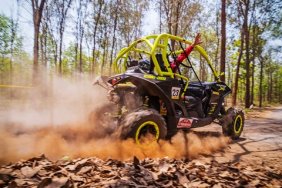 The Consumer Product Safety Commission has done a study that confirms what common sense tells us: a vast majority of injuries to the head in ATV accidents could be prevented or greatly reduced if every rider wore a helmet. It’s the number one and most important piece of ATV safety equipment.
The Consumer Product Safety Commission has done a study that confirms what common sense tells us: a vast majority of injuries to the head in ATV accidents could be prevented or greatly reduced if every rider wore a helmet. It’s the number one and most important piece of ATV safety equipment.
The head is the most vulnerable part of the body during a fall. In many types of crash scenarios, the head is whipped to the ground after other parts of the body – back, shoulders, chest – have hit, so the impact has more momentum. But a helmet doesn’t just offer protection during a tumble; it also serves as a shield against any flying debris the ATV kicks up: things like rocks, dirt, and branches. And if you are riding in a group, the amount of debris that can blow back toward you multiplies. Debris from other ATV riders can be thrown up by their tires, hitting those riding behind or beside them.
Your helmet protects your ears, mouth, nose, and if worn with goggles, your eyes. A motocross helmet even has a guard that extends in front of the mouth, with a rise in the middle to shield the nose. This style of helmet provides extra protection from flying debris.
Strapping on a helmet every single time you ride your ATV is the smart and responsible thing to do. If your children ride, a helmet for them is a must. As a parent, it’s your job to protect them and one way to do that is to make wearing a helmet mandatory. Kids don’t understand how badly they can get hurt without one, but they’ll happily follow your lead. If you wear your helmet every time you ride, they’ll gear up the same way. The ritual of checking your equipment and donning your safety gear should be a pre-ride habit for all ATV enthusiasts of every age.
A good helmet is not inexpensive, but it is the single most important piece of riding gear you’ll purchase. This is one time not to try to save money by purchasing the cheapest equipment. Look for a helmet that’s lightweight and durable, in either a full face or open face style. Most people prefer a helmet with opening and closing vents so it can be adjusted as needed for comfort in any temperature. The helmet you choose should be a brand that’s approved by the Department of Transportation and has a Snell rating. This assures that the helmet has met rigorous guidelines for both safety and performance.








